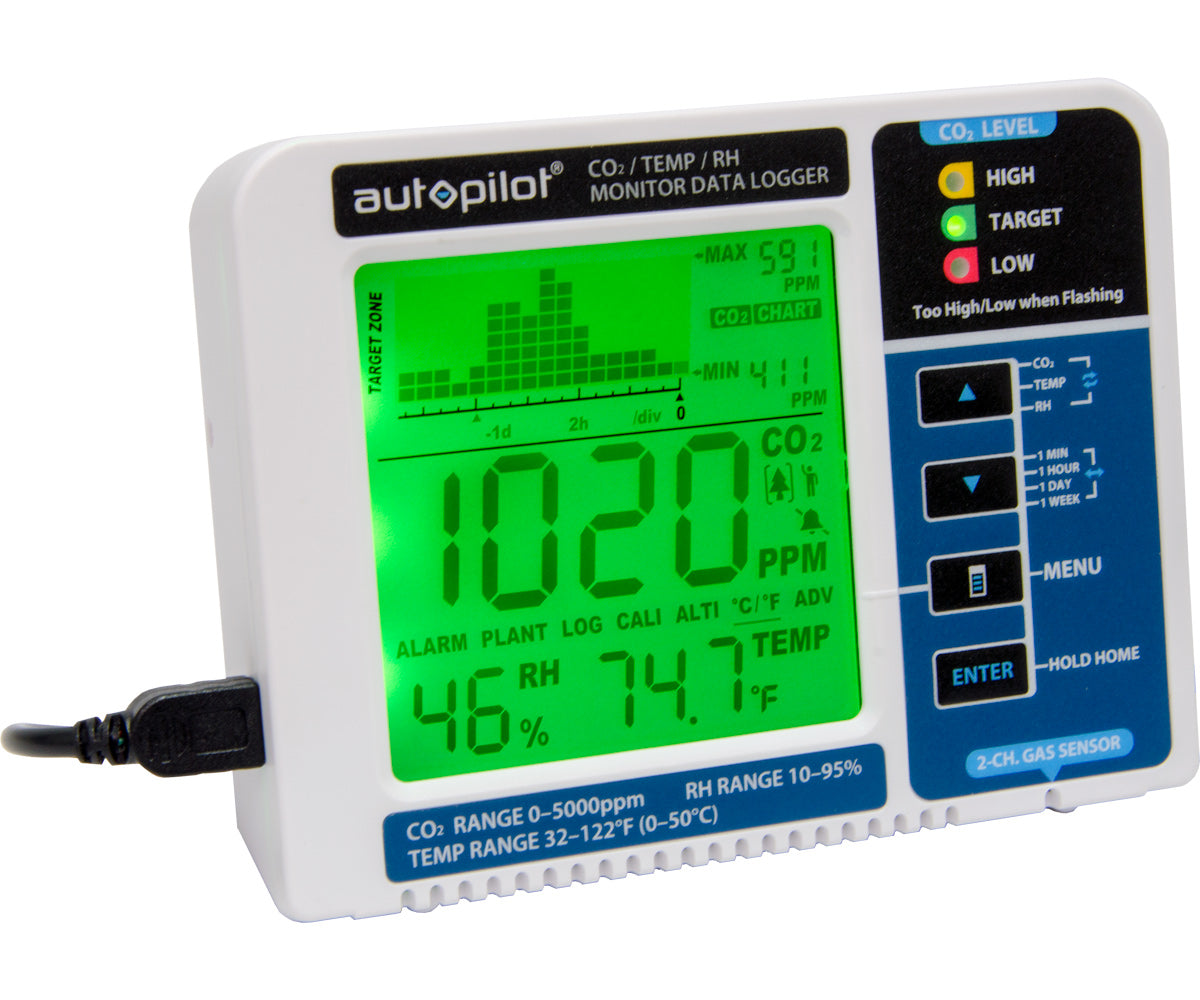Autopilot
Autopilot Desktop CO2 Monitor
Autopilot Desktop CO2 Monitor
20 in stock
Couldn't load pickup availability
Payment options
- Fast Delivery
- Easy Returns
- Secure Checkout
Description
Description
The Autopilot Desktop CO2 Monitor is an advanced monitoring device designed to provide growers with accurate and real-time measurements of carbon dioxide (CO2) levels in indoor gardening environments. This compact and user-friendly monitor is an essential tool for growers seeking to optimize atmospheric conditions, ensuring that plants receive the ideal CO2 concentrations for enhanced photosynthesis, growth, and overall productivity.
Key Features:
High-Resolution Display: The monitor features a high-resolution display that provides clear and easy-to-read information on CO2 levels. The display typically shows the current CO2 concentration in parts per million (ppm) for quick assessment.
Real-Time Monitoring: The Autopilot Desktop CO2 Monitor continuously monitors CO2 levels in real-time, allowing growers to observe fluctuations and trends throughout the day. This real-time feedback is crucial for making timely adjustments to maintain optimal conditions.
Accurate Sensor Technology: Equipped with advanced sensor technology, the monitor ensures accurate and reliable CO2 measurements. This precision is vital for growers who require exact data to make informed decisions about their cultivation environment.
User-Friendly Interface: The user-friendly interface simplifies the process of checking and interpreting CO2 levels. Growers can quickly navigate through the monitor's features, view historical data, and set preferences as needed.
Selectable Display Units: The monitor allows users to choose between different units for CO2 concentration display, such as parts per million (ppm) or grams per cubic meter (g/m³), based on their preferences or regional standards.
Data Logging: Some models of the Autopilot Desktop CO2 Monitor may include data logging capabilities. This feature enables growers to track and analyze CO2 trends over time, facilitating a deeper understanding of the environmental conditions within their growing space.
Compact Design: The desktop design of the monitor is compact and space-efficient, making it easy to integrate into various indoor gardening setups. It can be conveniently placed on a desk, shelf, or mounted on a wall for optimal visibility.
Plug-and-Play Installation: The monitor is designed for easy installation and use. It often comes with a plug-and-play setup, allowing growers to quickly incorporate the device into their grow room or greenhouse without the need for complex installation procedures.
Battery or AC Power Options: Some models may offer the flexibility of using either batteries or AC power, providing options for growers based on their preferences and the availability of power sources in their cultivation space.
Alarm Notifications: Certain models may include programmable high and low CO2 concentration alarms. These alarms alert growers when CO2 levels deviate from the desired range, enabling them to take prompt corrective actions.
Compatibility: The Autopilot Desktop CO2 Monitor is compatible with various indoor gardening setups, including hydroponic systems, grow tents, and greenhouses. Its versatility makes it suitable for a wide range of cultivation methods.
Routine Maintenance: While generally low-maintenance, routine checks and calibrations, if required, should be performed to ensure the accuracy of CO2 measurements.
Usage Tips:
Placement: Position the monitor at plant canopy height for accurate measurement of the CO2 levels experienced by the plants.
Calibration: Follow the manufacturer's guidelines for calibration procedures to maintain accurate CO2 readings.
Data Interpretation: Regularly review historical data and trends to gain insights into the environmental conditions and make informed adjustments.
Alarms: Set alarms at levels that align with optimal CO2 concentrations for different growth stages while considering safety limits.
Power Source: Choose between battery and AC power based on the specific requirements and setup of the growing environment.
Data Logging (if available): Take advantage of data logging features to track changes over time and make informed decisions about environmental adjustments.
The Autopilot Desktop CO2 Monitor is an indispensable tool for growers who prioritize precision and control in their indoor gardening endeavors. Its combination of accurate sensing technology, user-friendly interface, and versatile features makes it an excellent choice for optimizing CO2 levels and promoting robust plant growth.
Share

INFORMATION QUESTIONS
FREQUENTLY ASKED QUESTIONS
What is Hydroponics?
Hydroponics is the science of growing plants without soil. The plants thrive on the nutrient-water solution alone. The growing medium merely acts as a support for the plants and their root systems while the solution passes freely. The growing medium, if any, is totally inert.
What types of plants grow best hydroponically?
Anything can be grown hydroponically, but some plants prove to be more space efficient. Some plants we suggest are tomatoes, sweet peppers, hot chilies, lettuce, spinach, squash, cucumbers, broccoli, beans, snow peas, herbs and flowers of all types.
Can you REALLY get better yields/quicker growth?
Absolutely. The plants, when receiving everything they need, tend to be healthier, faster growing and generally more productive. You can expect 30% faster growth with many crops.
What are the watering cycle timelines hydroponic systems?
Once the reservoir is filled with nutrients, it is time to put your hydro system to work! The ease of hydroponics is automation – automation is achieved by putting the pump on a timer according to your watering needs. The watering cycle depends on growth stage, growing medium and hydroponic system. In an ebb and flow or drip system with rockwool as the medium, seedlings, clones and plants in the early vegetative stage require watering only once a day for 15-30 minutes (twice a day for higher temps). Mature, flowering and fruiting plants require a heavier feed and can be fed once a day for 30 minutes (twice a day for higher temps). Typically soiless mixes and coco fiber can be watered for about 15 minutes twice a day, and can be adjusted for heavier feeding during the flowering and fruiting stage or higher temps. ViaStone, Hydroton, Grow Rocks, and Silicate mediums need to be watered more frequently – a constant drip for drip systems, and about 15-30 minutes every 3 hours for ebb and flow systems and can be adjusted for heavier feeding during the flowering and fruiting stage or higher temps. Aeroponic systems require frequent watering cycles; 30-60 seconds every few minutes or a constant spray.
What do I need to test pH? How do I test pH?
pH has a range from 0 (acidic) – 14 (alkaline), with 7 being neutral. A proper hydroponic pH range is between 5.5 to 6.2 for most hydroponic crops. For specific crop pH, check out our Plant Guide. pH must remain within the proper range for good plant health, disease resistance, and proper nutrient uptake. pH is maintained by adding pH Up and pH Down to the nutrient solution. For more information, see the Testssection of our site.
How will the flavor compare to my outdoor grown, organic produce?
The taste may be even better! This is simply due to the fact that the hydroponically grown plants are getting everything they need, when they need it. Don’t be fooled by “hot house” produce grown commercially. The grower’s primary concern is shipability and storage, not flavor. When you grow your own vegetables at home, you can expect nothing less than excellent results. Plus, hydroponically grown produce has the added benefit of a longer shelf life.

